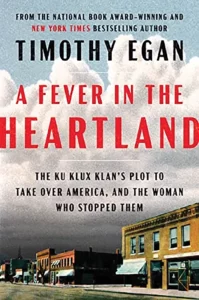‘A Fever In The Heartland’
1/3/2024 Twenty one years ago, Chuck Offenburger and I had ringside seats for a rare and fascinating journalistic forum: the now late George “Lefty” Mills, the legendary Des Moines Register reporter; the late Bob Beck, the former publisher of Centerville’s Daily Iowegian, a towering figure in journalism and Republican politics for decades; and my uncle, James B. Wilson, the then-publisher of the Carroll Daily Times Herald, sat around a table at Noah’s restaurant in Des Moines and talked for nearly two hours about newspapers, politics and Iowa.
Twenty one years ago, Chuck Offenburger and I had ringside seats for a rare and fascinating journalistic forum: the now late George “Lefty” Mills, the legendary Des Moines Register reporter; the late Bob Beck, the former publisher of Centerville’s Daily Iowegian, a towering figure in journalism and Republican politics for decades; and my uncle, James B. Wilson, the then-publisher of the Carroll Daily Times Herald, sat around a table at Noah’s restaurant in Des Moines and talked for nearly two hours about newspapers, politics and Iowa.
Offenburger recorded the notes, and I took the photos. Neither Chuck nor I talked much.
“Mills and Beck both figure they did their newspapering in the industry’s glory years,” Offenburger wrote in a fantastic piece that ran in February of 2002.
Beck grew up in Centerville where his father, Jesse M. Beck, was at the Iowegian from 1903 until 1965.
Under Jesse Beck, The Iowegian waged a sustained — and ultimately successful — fight against the Ku Klux Klan in southern Iowa, where the KKK had gained a foothold that modern Iowans would find astonishing. The paper editorialized against the KKK on its front page and faced reprisals from Klan supporters, Mills told us.
The accounts of this period, for those who want to learn more, are laid out in great detail in Enfys McMurry’s book, “Centerville: A Mid-American Saga.” I had a copy of it in my office here in Carroll and often refer to it for inspiration when I get down on things.
Memories of that lunch came racing back to me as I finished Timothy Egan’s remarkable book, “A Fever in the Heartland: The Ku Klux Klan’s Plot to Take Over America, and the Woman Who Stopped Them.”
The Klan during the 1920s — motivated as much by anti-Catholicism as racism — controlled vast swaths of the Midwest, populating legislatures, a governor’s office in Indiana, and courts and other reaches of power.
“When hate was on the ballot, especially in the guise of virtue, a majority of voters knew exactly what to do,” Egan writes of the “true mood in the Heartland of the 1920s.”
Nowhere was the influence of the Klan more profound than in Indiana, the center of Egan’s riveting non-fiction work, a chronicling of the rise of one of the more monstrous, but surprisingly little-known (until now), figures in American history, the Klan leader D.C. Stephenson, who shepherded the organization to rocketing growth and influence — so much so that the Grand Dragon of the Indiana Klan had a not-unthinkable strategy to run for president in 1928.
“What if the leaders of the 1920s Klan didn’t drive public sentiment but rode it?” Egan writes. “A vein of hatred was always there for the tapping. It’s there still, and explains much of the madness threatening American life.”
The Pulitzer-winning Egan covers the history and expansion of the Klan in the early 20th century — in the Midwest — before getting into extensive writing about one of the more consequential trials in American history, one I learned about reading “Fever In The Heartland.”
It’s page-turning prose from Egan that brings horrors of American history to modern eyes. The sentences are painful to process, such is the savagery of the Klan. On occasion one has to set the book down, walk away, digest the inhumanity.
A barbaric sociopath, Stephenson preyed on women, assaulting them with such brutality that reading Egan’s accounts, again, is challenging.
One of the victims, a young Indiana woman, Madge Oberholtzer, died from an attack. She provided detailed deathbed testimony, and her family advocated for a trial, a brave decision in light of Stephenson’s grip on the state’s power structure. The result: a trial in the Hamilton Courthouse in Noblesville, Indiana.
Had Madge Oberholtzer not come forward with the full story in her final days, Stephenson would have continued to abuse women and likely remained ascendent as a leader of the Klan. Had the happened, the decision-making on United States involvement in World War II could have been decidedly different.
Stephenson’s ultimate conviction and prison sentencing broke the fever-hold of the Klan in Indiana and catalyzed fights against it across the Midwest.
As Egan’s title tells us, Madge Oberholtzer is the peerless hero of the fight against the Klan in Indiana.
Egan’s book also references the fierce resistance from some Midwestern newspapers — notably the editor of a Muncie, Indiana, weekly newspaper, George Dale, who took on Stephenson and the Klan and had his house stoned and shot.
And William Allen White, the famous 20th century rural newspaper owner from Emporia, Kansas, who traveled his state and gave speeches over two months, an effort that led to a ban on the Klan in Kansas.
One Colorado observer had this thought as Klan influence waned in the 1920s: “The air of America is too friendly to permit such a disease to last.”
Egan’s epilogue questions whether the better angels of our nature are prevailing today. ♦
Douglas Burns of Carroll is fourth-generation journalist and founder of Mercury Boost, a marketing and public relations company.





















